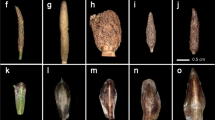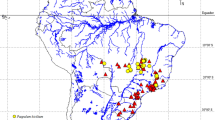Abstract
Allozyme markers from ten European taxa ofViola subsectionViola suggest that this group is allotetraploid, based on x = 5. All taxa had distinct multilocus phenotypes exceptV. alba subspp.alba andscotophylla, which were identical and different from subsp.dehnhardtii. Variation was consistently higher in Mediterranean populations than in North European ones. Hybridisation seems extensive but putative F1 hybrids were distinctly less fertile than the parental species. Nevertheless, increased fertility in later-generation hybrids and shared band patterns among taxa indicate an important role of hybridisation and introgression in past and present evolution within the subsection. The octoploidV. ambigua shows affinity toV. hirta (tetraploid). The octoploidV. suavis probably originated fromV. pyrenaica and other unidentified tetraploids, and high variability suggests polytopy or even polyphyly. The stoloniferous condition (seriesFlagellatae) seems to be primitive in the subsection but the reduction of stolons (seriesEflagellatae) may have originated multiple times.
Similar content being viewed by others
References
Anonymous (1996) Flora of China checklist and distribution maps (version 07. Sep. 1998). URL http://mobot.mobot.org/Pick/Search/index/fact. html
Arnold M. L. (1997) Natural hybridization and evolution (Oxford series in ecology and evolution). Oxford University Press, Oxford.
Arnold M. L., Bulger M. R., Bruke J. M., Hempel A. L., Williams J. H. (1999) Natural hybridization: How long can you go and still be important? Ecology 80: 371–381.
Asins M. J., Breto M. P., Cambra M., Carbonell E. A. (1993) Salt tolerance inLycopersicon species: I. Character definition and changes in gene expression. Theor. Appl. Genet. 86: 737–743.
Asins M. J., Herrero R., Navarro L. (1995) Factors affectingCitrus tree isozyme-gene expression. Theor. Appl. Genet. 90: 892–898.
Ballard H. E. Jr., Sytsma K. J., Kowal R. R. (1999) Shrinking the violets: Phylogenetic relationships of infrageneric groups inViola (Violaceae) based in internal transcribed spacer DNA sequences. Syst. Bot. 23: 439–458.
Banasinska A., Kuta E. (1996) Allogamy inViola odorata L. Acta Biol. Cracov. Ser. Bot. 38: 41–53.
Barrett S. C. H., Kohn J. R. (1991) Genetic and evolutionary consequences of small population size in plants. In: Falk D. A., Holsinger K. E. (eds.) Genetics and conservation of rare plants. Oxford University Press, New York, pp. 3–27.
Beattie A. J. (1969a) The floral biology of three species ofViola. New Phytol. 68: 1187–1201.
Beattie A. J. (1969b) The pollination ecology ofViola 1. Pollen containts in stigmatic cavities. Watsonia 7: 142–156.
Beattie A. J. (1971) Pollination mechanisms inViola. New Phytol. 70: 343–360.
Beattie A. J. (1972) The pollination ecology ofViola 2. Pollen loads of insect-visitors. Watsonia 9: 13–25.
Beattie A. J. (1974) Floral evolution inViola. Ann. Missouri Bot. Gard. 61: 781–793.
Becker W. (1903)Viola sepincola Jord. 1849 =Viola Beraudii Bor. 1857 =Viola Austriaca A. & J. Kerner 1872 =Viola cyanea Čel. 1872. Allg. Bot. Z. 9: 114–118.
Becker W. (1908) Beiträge zur Violenflora Asiens. Bull. Herb. Boissier, ser. 2: 739–744.
Becker W. (1910) Violae Europaeae. Verlag von C. Heinrich, Dresden-N.
Becker W. (1918) Violae Asiaticae et Australenses III. Beih. Bot. Ctrlbl. 36: 15–59.
Becker W. (1925) In: Engler A., Prantl K. (eds.) Die natürlichen Pfanzenfamilien 21: 363–376.
Bergdolt E. (1932) Morphologische und physiologische Untersuchungen überViola. Bot. Abh. 20: 8–120.
Bethke A. (1882) Über die Bastarde der Veilchen-Arten. Inaugural-Dissertation zur Erlangung der Doctorwürde von der philosophischen Facultät der Albertus-Universität zu Königsberg i. Pr.: 1–20.
Candolle A. P. De (1824)Viola serpens Wall. Candolle, prodr. 1: 296.
Chodat L. (1924) Contributions à la géo-botanique de Majorque. Genève: Thèse No. 734.
Clausen J. (1929) Chromosome number and the relationship of some North American species ofViola. Ann. Bot. 43: 741–764.
Clausen J. (1962) Stages in the evolution of plant species. Hafner Publishing Company, New York.
Crawford D. J. (1989) Enzyme electrophoresis and plant systematics. In: Soltis D. E., Soltis P. S. (eds.) Isozymes in plant biology. (Advances in plant sciences, series 4) pp. 146–164.
Culley T. M. (submitted) Inbreeding depression inViola canadensis (Violaceae), a species with chasmogamous and cleistogamous flowers (preliminary title).
Culley T. M., Wolfe A. D. (2000) Population genetic structure of the cleistogamous plant species,Viola pubescens, as indicated by isozyme and ISSR molecular markers. Mol. Ecol. (in press).
Culver D. C., Beattie A. J. (1980) The fate ofViola seeds dispersed by ants. Am. J. Bot. 67: 710–714.
Demesure B., Comps B., Petit J. R. (1996) Chloroplast DNA phylogeography of the common beech (Fagus sylvatica L.) in Europe. Evolution 50: 2515–2520.
Dizerbo A. H. (1967) Observations surViola odorata L.,Viola hirta L. et leur hybrideViola permixta Jord. dans le Massif Armoricain I–II. Bull. Soc. Sci. Bretagne 42: 113–124 & 215–223.
Dizerbo A. H. (1968) Observations surViola odorata L.,Viola hirta L. et leur hybrideViola permixta Jord. dans le Massif Armoricain III–IV. Bull. Soc. Sci. Bretagne 43: 71–79 & 225–236.
Dodd J. D., Gershoy A. (1943) Experiments in the grafting of species in the genusViola. Bull. Torrey Bot. Club 70: 91.
Erdner E. (1907) Sind die Veilchenbastarde fruchtbar oder nicht? Allg. Bot. Zeitschr. 7/8: 117–118.
Fægri K. (1996) Introduction. In: Fægri K., Danielsen A. (eds.) Maps of distribution of Norwegian vascular plants, Vol. 3. The southeastern element. Fagbokforlaget, Bergen, pp. 9–16.
Fukarek F. (1995) Florenentwicklung im Eiszeitalter. In: Fukarek F. (ed.) Urania Pflanzenreich 4. Vegetation, Urania-Verlag, Leipzig, pp. 61–67.
Gams H. (1925) Violaceae. In: Hegi G. (ed.) Illustrierte Flora von Mittel-Europa, Vol. 5. J. F. Lehmanns Verlag, München, pp. 585–657.
Gershoy A. (1934) Studies in North American violets III. Chromosome numbers and species characters. Vermont Agric. Sta. Bull. 367: 1–91.
Gerstlauer L. (1943) Vorschläge zur Systematik der einheimischen Veilchen. Ber. Bayer. Bot. Ges. 26: 12–55.
Gil-ad N. L. (1997) Systematics ofViola subsectionBoreali-Americanae. Boissiera 53: 1–130.
Gower J. C. (1966) Some distance properties of latent root and vector methods used in multivariate analysis. Biometrica 53: 325–338.
Grime J. P., Hodgson J. G., Hunt R. (1990) The abridged plant ecology. Unwin Hyman, London.
Grintescu G., Gusuleac M., Nyárády E. I. (1955)Viola L. In: Savulescu T. (ed.) Flora Republicii Populare Romîne, Vol. 2. Editura Academiei Republicii Populare Romîne.
Haesler I. (1982) Lectotypisierung der ArtenViola hirta L. undViola odorata L. Mitt. Bot. München 18: 289–96.
Heilborn O. (1926) Bidrag til Violaceernas cytologi. Sven. Bot. Tidskr. 20: 414–419.
Hess H. E., Landolt E., Hirzel R. (1970) Flora der Schweiz. Birkhäuser, Basel.
Hiemeyer F. (1992) Über einheimische Veilchen und ihre Kreuzungen im Mittelschwäbischen Raum — Beobachtungen und Erkenntnisse. Ber. Bayer. Bot. Ges. 63: 81–102.
Hultén E., Fries M. (1986) Atlas of North European vascular plants, Vol. 2. Koeltz Scientific Books, Königstein.
Kephart S. (1990) Starch gel electrophoresis of plant isozymes: a comparative analysis of techniques. Am. J. Bot. 77: 693–712.
Kim K. S., Sun B. Y., Whang S. S., Chung G. H. (1991) Comparative morphology of theViola albida complex. Korean J. Bot. 34: 229–238.
Kosonen L., Kaipiainen H., Kemppainen E. (1996) Suomen uhanalaiset lajit: Mäkiorvokki (Viola collina). Suomen ympäristö 75: 1–37.
Marcussen T., Borgen L., Nordal I. (submitted) Viola hirta and its relatives in Norway.
Marcussen T., Nordal I. (1998)Viola suavis, a new species in the Nordic flora, with analyses of the relation to other species in the subsectionViola (Violaceae). Nord. J. Bot. 18: 221–237.
Melchior H. (1939) Ein neues Veilchen aus SW.-Anatolien und die Phylogenie der Sprossentwicklung innerhalb der SektionNomimium. Feddes Repert. 46: 39–42.
Meusel H. (1978) Vergleichende Chorologie der Zentraleuropäischen Flora, Vol. 2. VEB Gustav Fischer Verlag, Jena.
Miyaji Y. (1929) Studien über die Zahlenverhältnisse der Chromosomen bei der GattungViola. Cytologia 1: 28–58.
Moore D. M. (1959) Population studies onViola lactea Sm. and its wild hybrids. Evolution 13: 318–332.
Morden C. W., Doebley J., Schertz K. F. (1987) A manual of techniques for starch gel electrophoresis ofSorghum isozymes. Texas: The Texas Agric. Exp. Stn. The Texas A and M Univ. System, College Station.
Mowrey B. D., Werner D. J. (1990) Developmental specific isozyme expression in peach. Hortscience 25: 219–222.
Muñoz Garmendia F., Montserrat P., Laínz M., Aldasoro J. J. (1993)Viola L. In: Castroviejo S., Aedo C., Cirujano S., Laínz M., Montserrat P., Morales R., Muñoz Garmendia F., Navarro C., Paiva J., Soriano C. (eds.) Flora Iberica, Vol. 3. Real Jardín Botánico, C.S.I.C., Madrid.
Neuffer B., Auge H., Mesch H., Amarell U., Brandl R. (1999) Spread of violets in polluted pine forests: Morphological and molecular evidence for the ecological importance of interspecific hybridization. Mol. Ecol. 8: 365–377.
Nordal I. (1996)Viola collina, V. hirta andV. odorata. In: Fægri K., Danielsen A. (eds.) Maps of distribution of Norwegian vascular plants, Vol. 3. The southeastern element. Fagbokforlaget, Bergen, pp. 115–116.
Nordal I., Jonsell B. (1998) A phylogeographic analysis ofViola rupestris — three postglacial immigration routes to the Nordic area? Bot. J. Linn. Soc. 128: 105–122.
Okamoto M., Okada H., Ueda K. (1993) Morphology and chromosome number ofViola pilosa, and its systematic position. Taxon 42: 781–787.
Petit C., Bretagnolle F., Felber F. (1999) Evolutionary consequences of diploid-polyploid hybrid zones in wild species. Trends Ecol. Evol. 14: 306–311.
Polunin O., Walters M. (1985) A guide to the vegetation of Britain and Europe. Oxford University Press, Oxford.
Redbo-Torstensson P., Berg H. (1995) Seasonal cleistogamy: a conditional strategy to provide reproductive assurance. Acta Bot. Neerl. 44: 247–256.
Rieseberg L. H., Ellstrand N. C. (1993) What can molecular and morphological markers tell us about plant hybridization? Crit. Rev. Pl. Sc. 12: 213–241.
Schmidt A. (1961) Zytotaxonomische Untersuchungen an europäischenViola-Arten der SektionNomimium. Österr. Bot. Zeitschr. 108: 20–88.
Schmidt A. (1962) Eine neue Grundzahl in der GattungViola. Zytotaxonomische Untersuchungen anViola parvula Tin. undViola occulta Lehm. Ber. Deutsch. Bot. Ges. 75: 78–84.
Schmidt A. (1964) Zur systematischen Stellung vonViola chelmea Boiss. Heldr. ssp.chelmea undV. delphinantha Boiss. Ber. Deutsch. Bot. Ges. 77: 256–261.
Schnarf K. (1922) Zur Samenentwicklung einigerViola-Bastarde. Österr. Bot. Zeitschr. 71: 190–199.
Schöfer G. (1954) Untersuchungen über die Polymorphie einheimischer Veilchen. Planta 43: 537–565.
Sokal R. R., Michener C. D. (1958) A statistical method for evaluating systematic relationships. Univ. of Kansas Sc. Bull. 38: 1409–1438.
Soltis D. E., Soltis P. S. (1989) Polyploidy, breeding system, and genetic differentiation in homosporous pteridophytes. In: Soltis D. E., Soltis P. S. (eds.) Isozymes in plant biology. (Advances in plant sciences, series 4), pp. 241–258.
Soltis D. E., Soltis P. S. (1993) Molecular data and the dynamic nature of polyploidy. Crit. Rev. Plant Sci. 12: 243–273.
Soltis D. E., Soltis P. S. (1999) Polyploidy: recurrent formation and genome evolution. Trends Ecol. Evol. 14: 348–352.
Strid A. (1986) Mountain flora of Greece. Cambridge University Press, Cambridge, p. 616.
Taberlet P. (1998) Biodiversity at the intraspecific level: The comparative phylogeographic approach. J. Biotech. 64: 91–100.
Taberlet P., Fumagalli L., Cosson A. M., Wust S., Andjean F. (1998) Comparative phylogeography and postglacial colonization routes in Europe. Mol. Ecol. 7: 453–464.
Tchourina O. (1909) Note sur leViola Jaubertiana Marès [sic]. Bull. Soc. Bot. Genève (Serie 2) 1: 204–207.
Valentine D. H. (1962) Variation and evolution in the genusViola. Preslia 34: 190–206.
Valentine D. H. (1975)Viola L. In: Stace C. A. (ed.) Hybridization and the Flora of the British Isles. Academic Press, London, pp. 154–163.
Valentine D. H., Merxmüller H., Schmidt A. (1968)Viola L. In: Tutin T. G., Heywood V. H., Burges N. A., Moore D. M., Valentine D. H., Walters S. M., Webb D. A. (eds.) Flora Europaea, Vol. 2. Cambridge University Press, Cambridge, pp. 270–282.
Wendel J. F. (1999) Genome evolution in polyploids. Pl. Mol. Biol. (in press).
Wendel J. F., Weeden N. F. (1989) Visualization and interpretation of plant isozymes. In: Soltis D. E., Soltis P. S. (eds.) Isozymes in plant biology. (Advances in plant sciences series 4), pp. 5–45.
Werth C. R. (1989) The use of isozyme data for inferring ancestry of polyploid pteridophytes. Biochem. Syst. Ecol. 17: 177–130.
Yuzepchuk S. V. (1949)Viola L. In: Shishkin B. K. (ed.) Flora of the U.S.S.R., Vol. 15. Israel: Israel Program for Scientific Translations (1974).
Author information
Authors and Affiliations
Rights and permissions
About this article
Cite this article
Marcussen, T., Borgen, L. Allozymic variation and relationships withinViola subsectionViola (Violaceae). Pl Syst Evol 223, 29–57 (2000). https://doi.org/10.1007/BF00985325
Received:
Accepted:
Issue Date:
DOI: https://doi.org/10.1007/BF00985325




